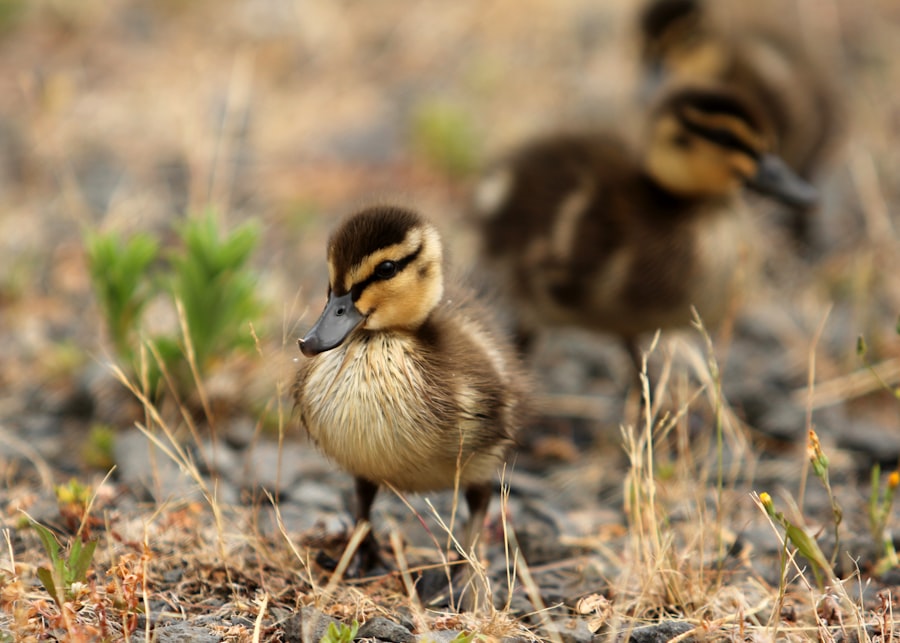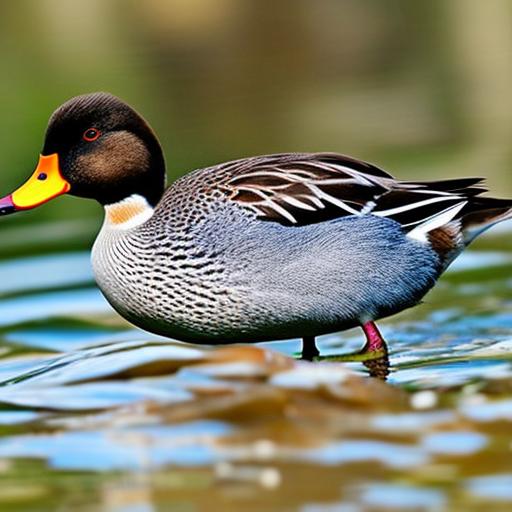Small duck breeds are a popular choice among backyard farmers due to their compact size and low maintenance requirements. These ducks are smaller in stature compared to their larger counterparts, making them easier to handle and manage. They are also suitable for small spaces, making them an ideal choice for those with limited backyard or farm space. In recent years, small duck breeds have gained popularity among hobby farmers and urban homesteaders who are looking to add ducks to their flock.
Key Takeaways
- Small duck breeds are becoming increasingly popular among backyard farmers and homesteaders.
- Raising small ducks can be advantageous due to their smaller size, lower feed requirements, and ability to forage for food.
- Small duck breeds have a long history, with some breeds dating back to ancient times.
- The most popular small duck breeds include the Call, East Indie, and Mallard.
- Small duck breeds are known for their hardiness, adaptability, and friendly personalities.
The Advantages of Raising Small Ducks
One of the main advantages of raising small ducks is the lower maintenance and feed costs associated with them. Due to their smaller size, they require less food compared to larger duck breeds. This can result in significant savings for backyard farmers, especially those on a tight budget. Additionally, small ducks produce less waste, which means less cleaning and maintenance for the farmer.
Another advantage of raising small ducks is that they are easier to handle and manage. Their smaller size makes them more manageable for children and individuals with limited physical strength. They are also less likely to cause damage or injury due to their smaller stature. This makes them a great choice for families or individuals who are new to raising ducks.
Small ducks are also suitable for small spaces, such as urban backyards or small farms. Their compact size allows them to thrive in areas where larger duck breeds may struggle. This makes them a popular choice among urban homesteaders who want to raise ducks but have limited space available.
The History of Small Duck Breeds
Small duck breeds have been around for centuries and have played an important role in agriculture and farming. These ducks were originally bred for their compact size and ability to thrive in various environments. They were often used by farmers who had limited space or resources but still wanted to raise ducks for meat, eggs, or pest control.
Over time, small duck breeds became popular among hobby farmers and backyard enthusiasts who were looking for a more manageable and low-maintenance option. These ducks were often bred for their unique characteristics and traits, such as their ability to lay a high number of eggs or their friendly and docile nature.
The Most Popular Small Duck Breeds
There are several small duck breeds that are popular among backyard farmers. One of the most popular breeds is the Call duck, which is known for its small size and distinctive quack. Call ducks are often kept as pets or for exhibition purposes due to their unique appearance and friendly nature.
Another popular small duck breed is the Indian Runner duck. These ducks are known for their upright posture and ability to run rather than waddle like other duck breeds. Indian Runner ducks are often kept for their high egg production and pest control abilities.
The Khaki Campbell duck is another popular small breed that is known for its excellent egg-laying abilities. These ducks can lay up to 300 eggs per year, making them a favorite among backyard farmers who are looking to raise ducks for eggs.
Characteristics of Small Duck Breeds
Small duck breeds have distinct physical characteristics that set them apart from larger duck breeds. They are typically smaller in size, with shorter legs and a compact body. Their feathers can come in a variety of colors, including white, black, brown, and various patterns.
In terms of behavior, small duck breeds are often known for their friendly and docile nature. They are generally less aggressive compared to larger duck breeds, making them easier to handle and manage. Small ducks also tend to be more curious and active, which can make them entertaining to watch.
Caring for Small Duck Breeds

Caring for small duck breeds is relatively straightforward and requires basic care requirements. They need access to clean water for swimming and drinking, as well as a balanced diet that includes a mix of commercial feed and fresh greens. Small ducks also require shelter that protects them from the elements and predators.
It is important to provide small ducks with regular veterinary care, including vaccinations and check-ups. Regular grooming, such as trimming their feathers and nails, is also necessary to keep them healthy and comfortable. Additionally, small ducks should be provided with ample space to roam and exercise, as this helps prevent boredom and promotes overall well-being.
Feeding Small Duck Breeds
Small duck breeds have specific dietary needs that should be met to ensure their health and well-being. They require a balanced diet that includes a mix of commercial duck feed, fresh greens, and insects. It is important to provide them with a high-quality feed that is specifically formulated for ducks, as this will provide them with the necessary nutrients they need to thrive.
Fresh water should always be available for small ducks, as they need it for drinking and swimming. It is important to regularly clean their water source to prevent the growth of bacteria or algae. Additionally, small ducks can benefit from occasional treats such as mealworms or fruits, but these should be given in moderation to prevent obesity or digestive issues.
Housing Small Duck Breeds
Small duck breeds require appropriate housing that provides them with protection from the elements and predators. A secure and spacious coop or shed should be provided, with enough room for the ducks to move around comfortably. The housing should also have proper ventilation to prevent the buildup of moisture and ammonia.
Bedding material such as straw or wood shavings should be provided in the housing to keep the ducks comfortable and to absorb moisture. The bedding should be cleaned regularly to maintain cleanliness and prevent the spread of diseases.
It is also important to provide small ducks with access to a secure outdoor area where they can roam and forage. This area should be fenced off to protect them from predators and should have access to clean water for swimming.
Breeding Small Duck Breeds
Breeding small duck breeds can be a rewarding experience for backyard farmers. To successfully breed small ducks, it is important to have a male and female duck of the same breed. The ducks should be of breeding age, which is typically around six months old.
The ducks should be provided with a suitable nesting area where the female can lay her eggs. This can be a simple nesting box filled with straw or shavings. The female will lay her eggs in the nesting box, and the male will fertilize them.
Once the eggs are laid, they should be collected and placed in an incubator or under a broody duck for hatching. The eggs will typically hatch after about 28 days, and the ducklings should be kept in a warm and safe environment until they are old enough to join the rest of the flock.
Health Issues and Concerns for Small Duck Breeds
Like any other animal, small duck breeds are susceptible to certain health issues and concerns. Some common health issues that affect small ducks include respiratory infections, parasites, and nutritional deficiencies. It is important to monitor the ducks closely for any signs of illness or distress and to seek veterinary care if necessary.
Preventing health issues in small ducks can be done through proper nutrition, regular veterinary care, and maintaining a clean and sanitary environment. Providing them with a balanced diet that meets their nutritional needs is essential for their overall health and well-being. Regular vaccinations and check-ups can help prevent diseases and catch any potential health issues early on.
In conclusion, small duck breeds offer several advantages for backyard farmers. They are low maintenance, easy to handle, and suitable for small spaces. Popular small duck breeds include Call ducks, Indian Runner ducks, and Khaki Campbell ducks. These ducks have distinct physical characteristics and behaviors that make them unique.
Caring for small duck breeds involves providing them with proper nutrition, housing, and veterinary care. Feeding them a balanced diet, providing them with a secure and comfortable housing, and regular veterinary check-ups are essential for their health and well-being. Breeding small duck breeds can be a rewarding experience, but it requires proper planning and care.
Overall, small duck breeds are a great addition to any backyard farm. They offer several benefits and can be a source of joy and entertainment for the whole family. Consider adding small duck breeds to your flock and enjoy the many advantages they bring.
If you’re interested in small duck breeds, you might also want to check out this informative article on poultrywizard.com about what to feed ducks. Feeding ducks the right diet is crucial for their health and well-being, and this article provides valuable insights and tips on what foods are best for them. Whether you’re a beginner or an experienced duck owner, understanding their dietary needs is essential. So, click here to learn more about feeding ducks and ensure they receive the proper nutrition they require.
FAQs
What are small duck breeds?
Small duck breeds are domesticated ducks that are smaller in size compared to other duck breeds. They are usually kept as pets or for ornamental purposes.
What are some examples of small duck breeds?
Some examples of small duck breeds include Call ducks, Mandarin ducks, Wood ducks, and Carolina ducks.
What is the average size of small duck breeds?
The average size of small duck breeds is around 1-2 pounds in weight and 12-15 inches in length.
What is the lifespan of small duck breeds?
The lifespan of small duck breeds can vary depending on the breed and their living conditions. On average, they can live up to 10-15 years.
What is the temperament of small duck breeds?
Small duck breeds are generally friendly and social. They can be easily trained and make great pets. However, like all animals, they can become aggressive if they feel threatened or if they are not properly socialized.
What is the diet of small duck breeds?
Small duck breeds require a diet that is high in protein and low in carbohydrates. They can be fed a variety of foods including commercial duck feed, vegetables, fruits, and insects.
What is the housing requirement for small duck breeds?
Small duck breeds require a secure and dry shelter that is protected from predators. They also need access to water for swimming and bathing. The housing should be cleaned regularly to prevent the spread of diseases.
Meet Walter, the feathered-friend fanatic of Florida! Nestled in the sunshine state, Walter struts through life with his feathered companions, clucking his way to happiness. With a coop that’s fancier than a five-star hotel, he’s the Don Juan of the chicken world. When he’s not teaching his hens to do the cha-cha, you’ll find him in a heated debate with his prized rooster, Sir Clucks-a-Lot. Walter’s poultry passion is no yolk; he’s the sunny-side-up guy you never knew you needed in your flock of friends!






